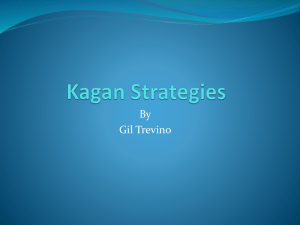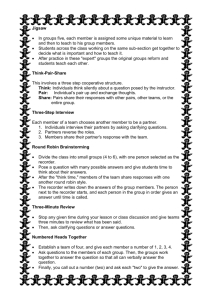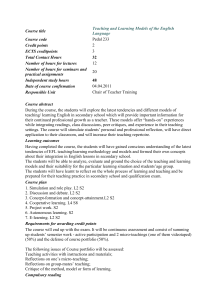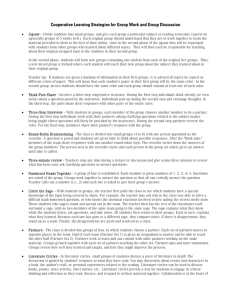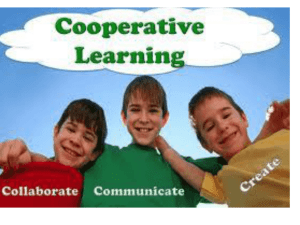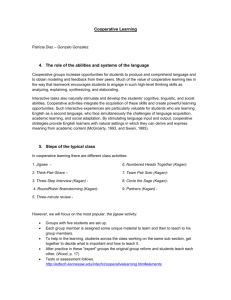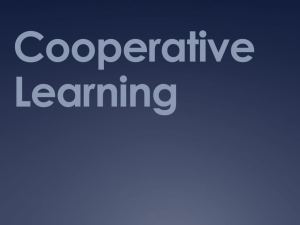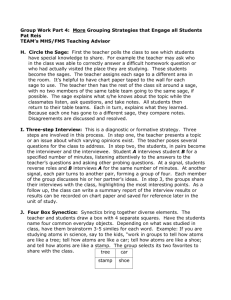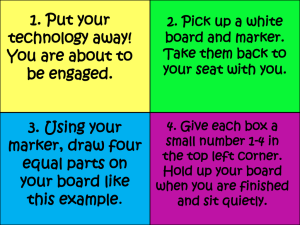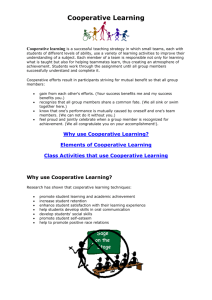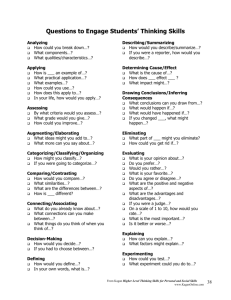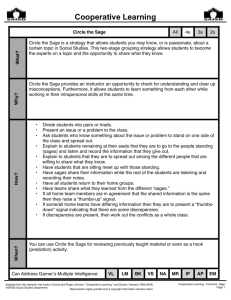Cooperative Learning BioSchol2013
advertisement
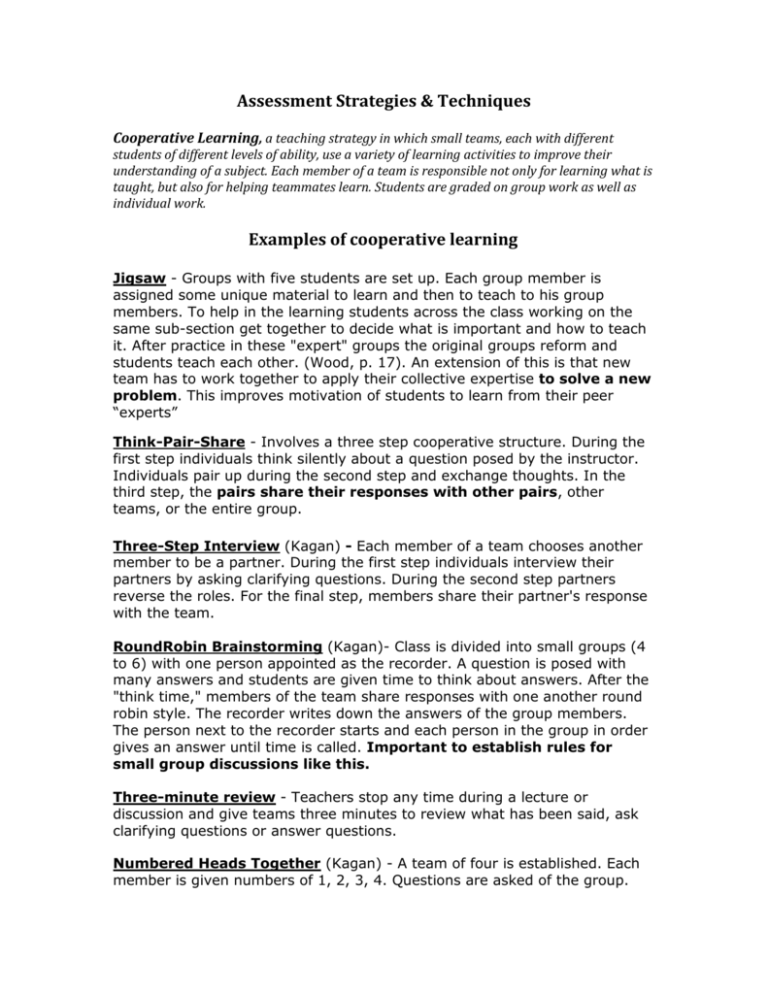
Assessment Strategies & Techniques Cooperative Learning, a teaching strategy in which small teams, each with different students of different levels of ability, use a variety of learning activities to improve their understanding of a subject. Each member of a team is responsible not only for learning what is taught, but also for helping teammates learn. Students are graded on group work as well as individual work. Examples of cooperative learning Jigsaw - Groups with five students are set up. Each group member is assigned some unique material to learn and then to teach to his group members. To help in the learning students across the class working on the same sub-section get together to decide what is important and how to teach it. After practice in these "expert" groups the original groups reform and students teach each other. (Wood, p. 17). An extension of this is that new team has to work together to apply their collective expertise to solve a new problem. This improves motivation of students to learn from their peer “experts” Think-Pair-Share - Involves a three step cooperative structure. During the first step individuals think silently about a question posed by the instructor. Individuals pair up during the second step and exchange thoughts. In the third step, the pairs share their responses with other pairs, other teams, or the entire group. Three-Step Interview (Kagan) - Each member of a team chooses another member to be a partner. During the first step individuals interview their partners by asking clarifying questions. During the second step partners reverse the roles. For the final step, members share their partner's response with the team. RoundRobin Brainstorming (Kagan)- Class is divided into small groups (4 to 6) with one person appointed as the recorder. A question is posed with many answers and students are given time to think about answers. After the "think time," members of the team share responses with one another round robin style. The recorder writes down the answers of the group members. The person next to the recorder starts and each person in the group in order gives an answer until time is called. Important to establish rules for small group discussions like this. Three-minute review - Teachers stop any time during a lecture or discussion and give teams three minutes to review what has been said, ask clarifying questions or answer questions. Numbered Heads Together (Kagan) - A team of four is established. Each member is given numbers of 1, 2, 3, 4. Questions are asked of the group. Groups work together to answer the question so that all can verbally answer the question. Teacher calls out a number (two) and each two is asked to give the answer. Team Pair Solo (Kagan)- Students do problems first as a team, then with a partner, and finally on their own. It is designed to motivate students to tackle and succeed at problems, which initially are beyond their ability. It is based on a simple notion of mediated learning. Students can do more things with help (mediation) than they can do alone. By allowing them to work on problems they could not do alone, first as a team and then with a partner, they progress to a point they can do alone that which at first they could do only with help. Circle the Sage (Kagan)- First the teacher polls the class to see which students have a special knowledge to share. For example the teacher may ask who in the class was able to solve a difficult math homework question, who had visited Mexico, who knows the chemical reactions involved in how salting the streets help dissipate snow. Those students (the sages) stand and spread out in the room. The teacher then has the rest of the classmates each surround a sage, with no two members of the same team going to the same sage. The sage explains what they know while the classmates listen, ask questions, and take notes. All students then return to their teams. Each in turn, explains what they learned. Because each one has gone to a different sage, they compare notes. If there is disagreement, they stand up as a team. Finally, the disagreements are aired and resolved. Establishing Team Rules I. Constructive and destructive group behaviors: What are yours? Constructive Group Behaviors Cooperating: Is interested in the views and perspectives of the other group members and is willing to adapt for the good of the group. Clarifying: Makes issues clear for the group by listening, summarizing and focusing discussions. Inspiring: Enlivens the group, encourages participation and progress. Harmonizing: Encourages group cohesion and collaboration. For example, uses humor as a relief after a particularly difficult discussion. Risk Taking: Is willing to risk possible personal loss or embarrassment for the group or project success. Process Checking: Questions the group on process issues such as agenda, time frames, discussion topics, decision methods, use of information, etc. Destructive Group Behaviors Dominating: Takes much of meeting time expressing self views and opinions. Tries to take control by use of power, time, etc. Rushing: Encourages the group to move on before task is complete. Gets "tired" of listening to others and working as a group. Withdrawing: Removes self from discussions or decision making. Refuses to participate. Discounting: Disregards or minimizes group or individual ideas or suggestions. Severe discounting behavior includes insults, which are often in the form of jokes. Digressing: Rambles, tells stories, and takes group away from primary purpose. Blocking: Impedes group progress by obstructing all ideas and suggestions. "That will never work because…" Brunt (1993). Facilitation Skills for Quality Improvement. Quality Enhancement Strategies. 1008 Fish Hatchery Road. Madison. WI 53715 II. Team Contract What key elements should your students include? III. Team Member Evaluation On what should the students be evaluated with respect to their team members’ contributions? Think rubric format How should points be assigned (everyone can get full credit or not and why?) IV. Design a cooperative learning experience that fits into the unit you are working on this week. Identify the learning objectives it addresses and how you think this will improve student learning when compared to you lecturing on the same content. Is the activity appropriate for the rubric your group created for team member evaluation, if not, how should you modify the team evaluation form? What are you constraining factors for implementing this experience in your class? How will you assess your students learning?
